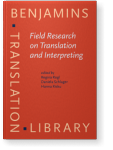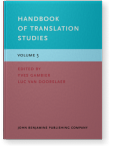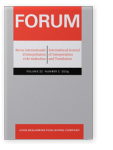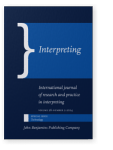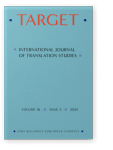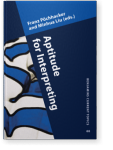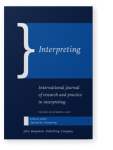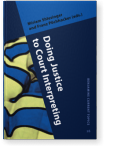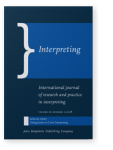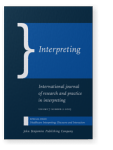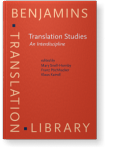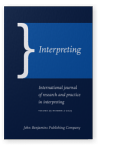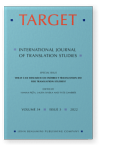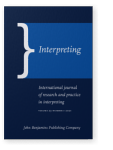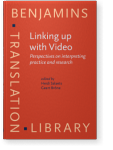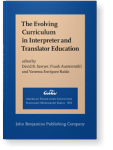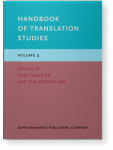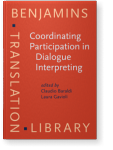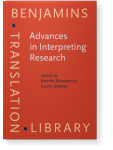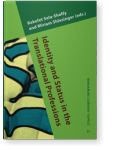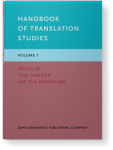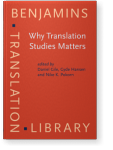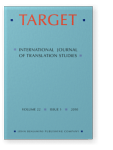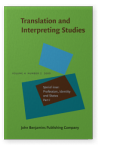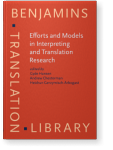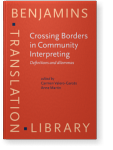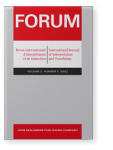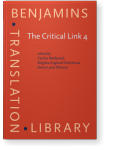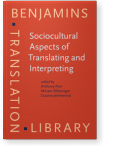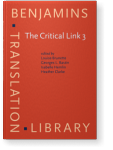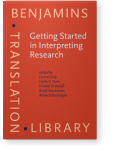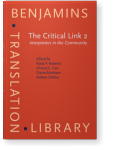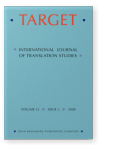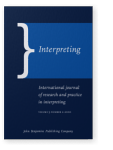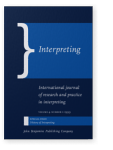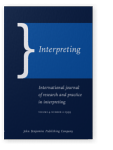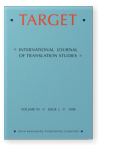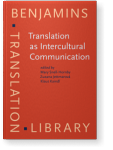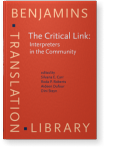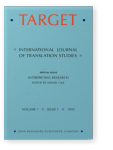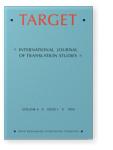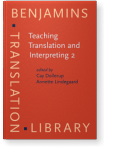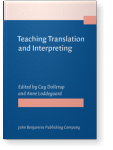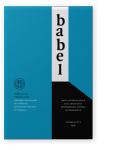Franz Pöchhacker
List of John Benjamins publications for which Franz Pöchhacker plays a role.
Book series
Online Resource
Journals
Technology
Edited by Franz Pöchhacker and Minhua Liu
Special issue of Interpreting 26:2 (2024) v, 174 pp.
Aptitude for Interpreting
Edited by Franz Pöchhacker and Minhua Liu
[Benjamins Current Topics, 68] 2014. v, 183 pp.
Subjects Interpreting | Translation Studies
Aptitude for Interpreting
Edited by Miriam Shlesinger † and Franz Pöchhacker
Special issue of Interpreting 13:1 (2011) vi, 153 pp.
Subjects Interpreting | Translation Studies
Doing Justice to Court Interpreting
Edited by Miriam Shlesinger † and Franz Pöchhacker
[Benjamins Current Topics, 26] 2010. viii, 246 pp.
Subjects Forensic & legal linguistics | Interpreting | Translation Studies
Doing Justice to Court Interpreting
Edited by Miriam Shlesinger † and Franz Pöchhacker
Special issue of Interpreting 10:1 (2008) 180 pp.
Subjects Interpreting | Translation Studies
Healthcare Interpreting: Discourse and Interaction
Edited by Franz Pöchhacker and Miriam Shlesinger †
[Benjamins Current Topics, 9] 2007. viii, 155 pp.
Subjects Discourse studies | Interpreting | Pragmatics
Healthcare Interpreting: Discourse and Interaction
Edited by Franz Pöchhacker and Miriam Shlesinger †
Special issue of Interpreting 7:2 (2005) 176 pp.
Subjects Interpreting | Translation Studies
Translation Studies: An Interdiscipline: Selected papers from the Translation Studies Congress, Vienna, 1992
Edited by Mary Snell-Hornby, Franz Pöchhacker and Klaus Kaindl
[Benjamins Translation Library, 2] 1994. xii, 438 pp.
Subjects Translation Studies
This article first considers the question whether machine translation is translation and moves on to address the analogous issue for interpreting. After a review of the development and state of the art in machine interpreting, more commonly referred to as ‘spoken language translation’ or ‘speech… read more
2024 Interpreting technologized: Distance and assistance Technology, Pöchhacker, Franz and Minhua Liu (eds.), pp. 157–177 | Introduction
As an introduction to a selection of current research on the theme of interpreting and technology this article offers an overview of the technologization of interpreting in the course of the past century, with particular emphasis on developments during recent decades. The application of various… read more
2023 Pioneering interpreting studies: The extraordinary case of Ingrid Kurz Interpreting 25:2, pp. 159–185 | Article
On the occasion of her 80th birthday, this article highlights the pioneering contribution of Ingrid Kurz to the development of interpreting studies. Following a biographical sketch describing her professional and academic career over half a century, the most important themes of her research are… read more
2022 Relay interpreting: Complexities of real-time indirect translation What can research on indirect translation do for Translation Studies?, Pięta, Hanna, Laura Ivaska and Yves Gambier (eds.), pp. 489–511 | Article
The unique features of interpreting as a situated process and performance to enable communication in real time make relay interpreting a particularly complex manifestation of indirect translation and a rich area of investigation. Even so, the great potential of relay interpreting as an object of… read more
2021 Multimodality in interpreting Handbook of Translation Studies: Volume 5, Gambier, Yves and Luc van Doorslaer (eds.), pp. 151–157 | Article
2021 Interpreting research in print: A quarter-century update Interpreting 23:1, pp. 1–17 | Editorial
2020 Chapter 1. “Going video”: Mediality and multimodality in interpreting Linking up with Video: Perspectives on interpreting practice and research, Salaets, Heidi and Geert Brône (eds.), pp. 13–45 | Chapter
This chapter explores the link between interpreting and video mainly by engaging in a conceptual analysis drawing on insights from social semiotics and communication studies. Departing from an understanding of speech as a semiotic mode in the oral-aural modality, the development of interpreting… read more
2019 Structure and process: A case study of the evolving interpreter education curriculum in Vienna The Evolving Curriculum in Interpreter and Translator Education: Stakeholder perspectives and voices, Sawyer, David B., Frank Austermühl and Vanessa Enríquez Raído (eds.), pp. 141–160 | Chapter
With a focus on several major reform efforts over the last quarter-century, this chapter describes and analyzes the legal and institutional frameworks that have been shaping the curriculum for interpreter education at the University of Vienna, where successive MA programs were created in 2003, 2007… read more
2019 Going out in style: An interview with Interpreting Style Editor Peter Mead Interpreting 21:1, pp. 1–11 | Interview
2018 Media interpreting: From user expectations to audience comprehension Reception Studies and Audiovisual Translation, Di Giovanni, Elena and Yves Gambier (eds.), pp. 253–276 | Chapter
This chapter offers a thorough conceptual analysis of media interpreting as a form of audiovisual translation, with special reference to interpreting performed for broadcast mass media programs, especially on television. Based on criteria such as interpreting modes, language modality and… read more
2014 Assessing aptitude for interpreting: The SynCloze test Aptitude for Interpreting, Pöchhacker, Franz and Minhua Liu (eds.), pp. 147–160 | Article
Based on a review of some of the most promising approaches to aptitude testing in the literature this paper proposes a novel task piloted at the Center for Translation Studies of the University of Vienna. The SynCloze test combines an auditory cloze exercise with a task requiring high expressional… read more
2013 Teaching interpreting/Training interpreters Handbook of Translation Studies: Volume 4, Gambier, Yves and Luc van Doorslaer (eds.), pp. 174–180 | Article
2012 2. Interpreting participation: Conceptual analysis and illustration of the interpreter’s role in interaction Coordinating Participation in Dialogue Interpreting, Baraldi, Claudio and Laura Gavioli (eds.), pp. 45–70 | Article
This chapter approaches the notion of participation in dialogue interpreting from both a theoretical and an empirical perspective. In a review of several analytical proposals for the distinction of speaker and hearer roles, it sketches a multi-level framework based on the distinction between the… read more
2011 Researching interpreting: Approaches to inquiry Advances in Interpreting Research: Inquiry in action, Nicodemus, Brenda and Laurie Swabey (eds.), pp. 5–26 | Article
This chapter addresses some of the more fundamental issues in research on interpreting. After a reflection on the purpose and use of research on interpreting, the diversity of concepts, models and interdisciplinary approaches is used as a point of departure for a reflection on the identity of the… read more
2011 Conference interpreting: Surveying the profession Identity and Status in the Translational Professions, Sela-Sheffy, Rakefet and Miriam Shlesinger † (eds.), pp. 49–64 | Article
2011 Assessing aptitude for interpreting: The SynCloze test Aptitude for Interpreting, Shlesinger, Miriam † and Franz Pöchhacker (eds.), pp. 106–120 | Article
Based on a review of some of the most promising approaches to aptitude testing in the literature this paper proposes a novel task piloted at the Center for Translation Studies of the University of Vienna. The SynCloze test combines an auditory cloze exercise with a task requiring high expressional… read more
2011 Aptitude for interpreting Aptitude for Interpreting, Shlesinger, Miriam † and Franz Pöchhacker (eds.), pp. 1–4 | Article
2010 Media interpreting Handbook of Translation Studies: Volume 1, Gambier, Yves and Luc van Doorslaer (eds.), pp. 224–226 | Article
2010 Why interpreting studies matters Why Translation Studies Matters, Gile, Daniel, Gyde Hansen and Nike K. Pokorn (eds.), pp. 3–14 | Article
This paper takes up the theme of the Ljubljana EST Congress from the perspective of interpreting studies. The basic assumption that the existence of a distinct research community dedicated to the study of interpreting corresponds to an epistemological need is illustrated with regard to related work… read more
2010 Interpreting Handbook of Translation Studies: Volume 1, Gambier, Yves and Luc van Doorslaer (eds.), pp. 153–157 | Article
2010 Hale, Sandra Beatriz. 2007. Community Interpreting Target 22:1, pp. 120–124 | Review
2010 Interpreting Studies Handbook of Translation Studies: Volume 1, Gambier, Yves and Luc van Doorslaer (eds.), pp. 158–172 | Article
2010 Introduction: Doing justice to court interpreting Doing Justice to Court Interpreting, Shlesinger, Miriam † and Franz Pöchhacker (eds.), pp. 1–7 | Miscellaneous
2009 Conference interpreting: Surveying the profession Profession, Identity and Status: Translators and Interpreters as an Occupational Group, Sela-Sheffy, Rakefet and Miriam Shlesinger † (eds.), pp. 172–186 | Article
This paper offers a review of survey research among conference interpreters as a way of gaining knowledge about the profession, including the role perception of individual practitioners. A corpus of 40 survey research studies is examined with regard to such research design issues as sampling and… read more
2009 8. Interpreting for the record: A case study of asylum review hearings The Critical Link 5: Quality in interpreting – a shared responsibility, Hale, Sandra, Uldis Ozolins and Ludmila Stern (eds.), pp. 119–134 | Article
This paper addresses a specific aspect of interpreting in Austrian asylum review hearings, i.e., the interpreter’s role as a co-producer of the written record. The interpreter-mediated encounter is viewed as a joint, co-constructed activity, with responsibility for its content, progression and… read more
2008 The turns of Interpreting Studies Efforts and Models in Interpreting and Translation Research: A tribute to Daniel Gile, Hansen, Gyde, Andrew Chesterman and Heidrun Gerzymisch-Arbogast (eds.), pp. 25–46 | Article
Borrowing from the title as well as relevant contents of Mary Snell-Hornby’s latest book on Translation Studies, this paper reviews the development of Interpreting Studies as an academic (sub)discipline and examines it for shifts and milestones that might qualify as “turns” while probing the… read more
2008 2. Interpreting as mediation Crossing Borders in Community Interpreting: Definitions and dilemmas, Valero Garcés, Carmen and Anne Martin (eds.), pp. 9–26 | Article
Addressing the theme of the Second Alcalá Conference on Public Service Interpreting and Translation, “translation as mediation”, this paper discusses whether and how the notion of mediation applies, or should be applied, to interpreting. The semantic and terminological complexities involved in the… read more
2007 “Going simul?” Technology-assisted Consecutive Interpreting1 FORUM 5:2, pp. 101–124 | Article
La prédominance de l'interprétation consécutive à base de notes, développée et utilisée par la première génération d'interprètes de la Ligue des Nations en vue des longs discours prononcés à la tribune a été cruciale pour la professionalistion de l'interprétariat au 20e siècle. Cependant, ce mode… read more
2007 Critical linking up: Kinship and convergence in interpreting studies The Critical Link 4: Professionalisation of interpreting in the community, Wadensjö, Cecilia, Birgitta Englund Dimitrova and Anna-Lena Nilsson (eds.), pp. 11–23 | Article
This paper broadly reflects on the identity and status of community-based interpreting as a field of practice and academic study. With a focus on research and its role in the process of professionalization, it explores the kinship among the various domains of interpreting from a historical,… read more
2006 “Going social?” On pathways and paradigms in interpreting studies Sociocultural Aspects of Translating and Interpreting, Pym, Anthony, Miriam Shlesinger † and Zuzana Jettmarová (eds.), pp. 215–232 | Article
As researchers are devoting more and more attention to aspects of interpreting that seemed marginal at best only fifteen years ago, the field of Interpreting Studies seems to be undergoing a shift or reorientation. This paper is an attempt to make sense of the changing landscape of interpreting… read more
2005 Introduction: Discourse-based research on healthcare interpreting Healthcare Interpreting: Discourse and Interaction, Pöchhacker, Franz and Miriam Shlesinger † (eds.), pp. 157–165 | Article
2003 Analysing Interpreted Doctor–Patient Communication from the Perspectives of Linguistics, Interpreting Studies and Health Sciences The Critical Link 3: Interpreters in the Community, Brunette, Louise, Georges L. Bastin, Isabelle Hemlin and Heather Clarke (eds.), pp. 67–79 | Article
2002 Researching interpreting quality: Models and methods Interpreting in the 21st Century: Challenges and opportunities, Garzone, Giuliana and Maurizio Viezzi (eds.), pp. 95–106 | Article
2001 Working within a theoretical framework Getting Started in Interpreting Research: Methodological reflections, personal accounts and advice for beginners, Gile, Daniel, Helle V. Dam, Friedel Dubslaff, Bodil Martinsen and Anne Schjoldager (eds.), pp. 199–219 | Article
2000 The Community Interpreter’s Task: Self-Perception and Provider Views The Critical Link 2: Interpreters in the Community, Roberts, Roda P., Silvana E. Carr, Diana Abraham and Aideen Dufour (eds.), pp. 49–66 | Article
2000 Wadensjö, Cecilia. 1998. Interpreting as Interaction Target 12:2, pp. 366–369 | Review
2000 Review of Mason (2001): Triadic exchanges. Studies in dialogue interpreting Interpreting 5:2, pp. 243–247 | Review
1999 'Getting Organized': The Evolution of Community Interpreting History of Interpreting, Kurz, Ingrid and Margareta Bowen (eds.), pp. 125–140 | Article
Based on a broad definition of the concept of community interpreting, the paper gives an overview of the development of community-based interpreting as a profession since the 1960s. Reviewing both the field of sign language interpreting and spoken-language community interpreting in the context of… read more
1998 Feldweg, Erich. 1996. Der Konferenzdolmetscher im internationalen Kommunikationsprozeß Target 10:2, pp. 383–386 | Review
1997 “Clinton speaks german”: A case study of live broadcast simultaneous interpreting Translation as Intercultural Communication: Selected papers from the EST Congress, Prague 1995, Snell-Hornby, Mary, Zuzana Jettmarová and Klaus Kaindl (eds.), pp. 207–216 | Article
1997 “Is there anybody out there?” community interpreting in austria The Critical Link: Interpreters in the Community: Papers from the 1st international conference on interpreting in legal, health and social service settings, Geneva Park, Canada, 1–4 June 1995, Carr, Silvana E., Roda P. Roberts, Aideen Dufour and Dini Steyn (eds.), pp. 215–226 | Article
1995 Lambert, Sylvie & Barbara Moser-Mercer, eds. 1994. Bridging the Gap: Empirical Research in Simultaneous Interpretation. Interpreting Research, Gile, Daniel (ed.), pp. 181–185 | Review
1995 “Those Who Do...”: A Profile of Research(ers) in Interpreting Interpreting Research, Gile, Daniel (ed.), pp. 47–64 | Article
In an attempt to survey the contemporary landscape of Interpreting Studies, the paper draws a profile of 'schools' of research(ers) based on the output of writings and research on interpreting in the years from 1989 to 1994. A ranking of the most productive authors in the period under study serves… read more
1994 Thelen, Marcel & Barbara Lewandowska-Tomaszczyk, eds. 1990. Translation and Meaning I: Proceedings of the Maastricht Session of the 1990 Maastricht-Lódź Duo Colloquium on “Translation and Meaning”. & Lewandowska-Tomaszczyk, Barbara & Marcel Thelen, eds. 1992. Translation and Meaning II: Proceedings of the Lódź Session of the 1990 Maastricht-Lódź Duo Colloquium on “Translation and Meaning”. Target 6:1, pp. 98–101 | Review
1994 Quality assurance in simultaneous interpreting Teaching Translation and Interpreting 2: Insights, aims and visions. Papers from the Second Language International Conference Elsinore, 1993, Dollerup, Cay and Annette Lindegaard (eds.), pp. 233–244 | Article
1994 Simultaneous interpretation: “Cultural transfer” or “voice-over text”? Translation Studies: An Interdiscipline: Selected papers from the Translation Studies Congress, Vienna, 1992, Snell-Hornby, Mary, Franz Pöchhacker and Klaus Kaindl (eds.), pp. 169–178 | Article
1992 The role of theory in simultaneous interpreting Teaching Translation and Interpreting: Training Talent and Experience. Papers from the First Language International Conference, Elsinore, Denmark, 1991, Dollerup, Cay and Anne Loddegaard (eds.), pp. 211–220 | Chapter
1991 Basil Hatim & Ian Mason: Discourse and the Translator Babel 37:2, pp. 119–122 | Review
